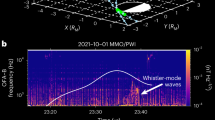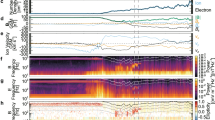Abstract
LIKE her sister Alouette I, the Alouette II satellite carries a broad band, very-low-frequency receiver, but the pass band has been extended to (0.05–30 kc/s) from (0.4–10 kc/s). The Alouette II orbit has almost the same inclination as that of Alouette I (∼ 80°), but is elliptical with a perigee of 501 km, and an apogee of 2,983 km, rather than the almost circular 1,000 km orbit of Alouette I. One of the significant discoveries made by analysis of very-low-frequency data recorded by the Alouette I satellite1 was that an atmospheric (an electromagnetic impulse originating from a lightning flash) that had propagated upwards to the satellite was often immediately followed by a novel type of very-low-frequency signal. Initially, the frequency of this signal rose rapidly; the rate of increase then gradually diminished until the frequency approached a nearly constant value. These signals have been termed proton whistlers, and analysis2 has shown that they are due to coupling of wave energy from the (electron) whistler mode into ion cyclotron waves. Such coupling is possible only at frequencies below the proton gyro-frequency. The coupling occurs over a range of heights below the satellite, with a given frequency component coupling most strongly at a height determined solely by the positive ion composition of the ionosphere. The resulting ion cyclotron waves propagate upwards to the satellite and suffer increasing time delay as their frequency approaches the local proton gyro-frequency. This interpretation explains the form of dispersion exhibited by proton whistler signals, and why such signals are observed only after the occurrence of a normal short fractional hop whistler as well as the manner in which the wave energy enters and propagates through the lower ionosphere.
This is a preview of subscription content, access via your institution
Access options
Subscribe to this journal
Receive 51 print issues and online access
$199.00 per year
only $3.90 per issue
Buy this article
- Purchase on Springer Link
- Instant access to full article PDF
Prices may be subject to local taxes which are calculated during checkout
Similar content being viewed by others
References
Smith, R. L., Brice, N. M., Katsufrakis, J., Gurnett, D. A., Shawhan, S. D., Belrose, J. S., and Barrington, R. E., Nature, 204, 274 (1965).
Gurnett, D. A., Shawhan, S. K., Brice, N. M., and Smith, R. L., J. Geophys. Res., 70, 1665 (1965).
Gurnett, D. A., and Shawhan, S. D., J. Geophys. Res., 71, 741 (1966).
Author information
Authors and Affiliations
Rights and permissions
About this article
Cite this article
BARRINGTON, R., BELROSE, J. & MATHER, W. A Helium Whistler observed in the Canadian Satellite Alouette II. Nature 210, 80–81 (1966). https://doi.org/10.1038/210080b0
Issue Date:
DOI: https://doi.org/10.1038/210080b0
This article is cited by
-
Deuteron whistlers in the outer ionosphere
Studia Geophysica et Geodaetica (1986)
-
e.l.f. Hiss modulation at harmonics of the helium gyrofrequency
Nature (1976)
-
Complex Ray Theory for Ion Cyclotron Whistlers
Nature Physical Science (1971)
-
Harmonic Ion Cyclotron Resonances observed by the OGO–4 Satellite
Nature (1970)
Comments
By submitting a comment you agree to abide by our Terms and Community Guidelines. If you find something abusive or that does not comply with our terms or guidelines please flag it as inappropriate.



